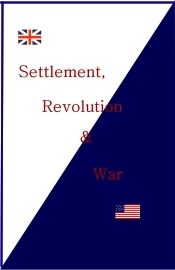
 Book #2: Settlement, Revolution & War.
Book #2: Settlement, Revolution & War.
Through the winter of 1812/1813 the admirals at London had to reflect on their very poor performance in the naval battles that they had had with the young United States.
"The captures of the Guerrière, Macedonian, Java, &c., while they encouraged the Americans to boast of naval prowess, created, naturally enough, an indignant feeling among the officers of the British navy. The prestige acquired by so many victories achieved by Howe, Duncan, Nelson, Cochrane and others, in the contests with the French, were in danger of being overshadowed by the successes of the Americans. The British naval officers felt that this was unfair. In all the encounters they had with United States ships, the balance as to weight of metal, size of vessels, number of crews, &c., had been in favour of their adversaries. Yet, the current of events was dimming their laurels, and injuring the confidence of victory, which had done so much for the red cross banner on the Atlantic."1The British admiralty was confounded by the British lack of success in American waters. The failure of their ships was not something the Admiralty Lords had experienced for many years. Enter Philip Bowes Vere Broke and his 38-gun Shannon.
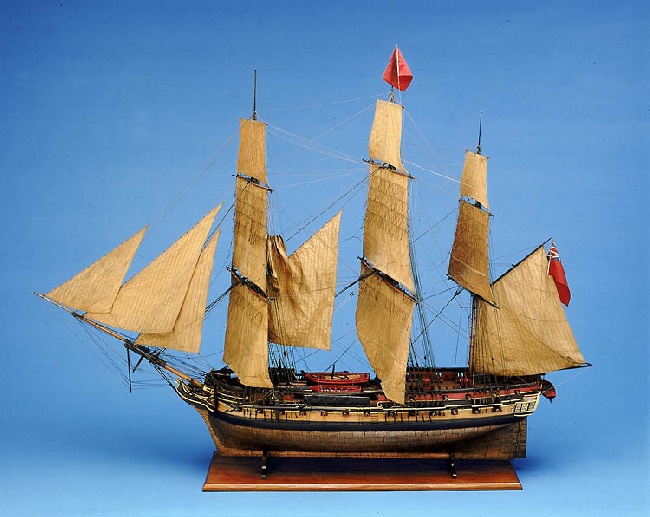
|
| A Model of the 38-Gun Frigate, HMS Shannon. |
John Liddell, a merchant at Halifax made note when the Shannon came in. It was September 24th, 1811: "Arrived HMS Shannon Captain Broke 45 days from Portsmouth."2
"By 22nd September the Shannon had reached Sable Island, and on the 24th she entered the spacious harbour of Halifax, base for the North American station. Here they found the Commander-in-chief, Vice-Admiral Sawyer, flying his flag in the Africa, a slow tub of a vessel of 64 guns, smaller than a line-of-battle ship, larger than a frigate, lacking the best features of both -- such was the Admiralty's estimate of the threat posed by the American Navy! With the Africa were four frigates, the Spartan, Aeolus, Guerriere, Belvidera and a number of sloops-of-war."3
Broke came to the Shannon in 1806; she was brand spanking new. "When her crew were completed she joined Commodore Owen's squadron off Boulogne and took part in the Congreve rocket bombardment of that town on 8 October."4 In 1807, the Shannon was sent into northern waters off Greenland in order to protect the whaling fleet. That September she was back in the Downs, and on September 28th she made for Spithead for a refit. Now at war with the Portuguese, a British fleet, which included the Shannon and other escorting warships and seventeen transports, assembled at Cork and sailed off to conquer Madeira, which they did, without a shot being fired. Shannon was next employed escorting the transports back to England. By February 7th, 1808, the Shannon was back at Plymouth from which she worked the Channel for a period of time. On June 1st, 1811, she was docked at Plymouth and re-coppered5, then sent to Portsmouth to complete for foreign service. And so, the Shannon came into Halifax, as already mentioned, on September 24th, 1811. She then joined a growing fleet of medium-sized war vessels which were blockading the American ports6 which service included the taking of any vessel with questionable cargo. At times she was detached in order to go along part way with a fleet of British cargo ships. "Captain Broke then sailed to meet the home bound Jamaican convoy which was under threat from an American squadron under Commodore Rogers which had sailed from New York to intercept it. He saw the convoy safely over the Great Banks then returned to the American coast to attack merchant shipping. Shannon arrived in Halifax on 20 September [1812] to victual and water."7
When Admiral Sir John Warren, who came to command the North Atlantic fleet, left for his winter digs at Bermuda, he left "Captain Broke in command of the squadrons on the coasts of Nova Scotia, New Brunswick and New England.8 In December he escorted a homebound convoy half way across the Atlantic and returned round the Azores."9 That spring, 1813, the Shannon and her well-disciplined and experienced crew, both at the guns and at the sails, were patrolling off Boston. It was known that the best ships of the young American navy were holed up in Boston Harbour. The USS Chesapeake, which was then refitting in Boston, came out, her captain interested in single ship combat. The Shannon had sent her traveling companion, the 38-gun HMS Tenedos, away, over the horizon. "The two ships met at half past five in the afternoon 20 miles east of Boston lighthouse between Cape Ann and Cape Cod. Shannon was flying a rusty blue ensign at the peak and her outside appearance suggested that she would be an easy opponent."10 Little did the men of the Chesapeake know of Captain Broke and his crew.
"The weekly routine at sea was for the watch on deck to be exercised at the great guns on Monday and Tuesday afternoons, and in the afternoons the first division of the watch was exercised at small arms. Wednesday and Thursday forenoons saw the watch on deck at the carronades, and in the afternoons the second division of the watch at small arms. Friday was reserved for the Midshipmen -- great guns in the morning, small arms in the afternoon. Thus each man had one morning at the 18-pounders, one morning at the carronades and two afternoons with musquets in every week. Saturdays were reserved for washing clothes and scrubbing the berth deck in the afternoon. Sunday, apart from Church service and any necessary evolutions with the sails, was free."11
In addition, as Padfield explained, field days were held aboard the Shannon. During such a day, all hands were drummed to quarters to deal with hypothetical situations which Broke devised. Sometimes Broke would alert the crew of a night attack, or he would arrange for a wooden cask to be sent over the side and there would be gunnery competitions as to which crew could hit it and how fast they could do so. Also the crew would be brought together so that they could play at a game called singlestick. "This was a game employing roughly similar thrusts and parries as were used with cutlass, but as it was played with blunt sticks, hits, although painful, were not often dangerous. It soon developed quickness of eye and wrist."12
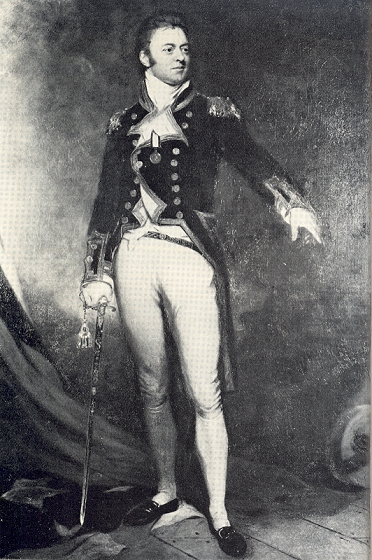
Philip Bowes Vere Broke was from "an old English family." The family seat was Broke Hall near Harwich. Born in 1776, he was the eldest son of Philip Bowes Broke. After some preparatory school work, Broke, as a young gentleman13 was sent off to the Royal Naval Academy at Portsmouth in 1788.
We add, parenthetically, that while Broke came from a well-connected family, his course of promotion, like most all royal naval officers, would rely on the ability that he demonstrated as an officer aboard a British warship. This was less the case in the army.
"The army was essentially an aristocratic, and the navy a comparatively democratic service. In the navy a man of obscure origin could rise, and the area of choice was not limited by the circumstances of birth; but in the army, purchase and favour and lineage gave promotion. Our admirals were not born in the purple. Collingwood was the son of a Newcastle merchant, Jervis of a country lawyer, Nelson of a country parson. But when our armies had to be sent into the field, it was necessary that, if possible, a prince of the blood should command them."14
The Broke family saw to it that they would have at least one son in each of the two services. Charles, the second oldest, joined the army and fought in Europe under Wellington and in time became a Major General and was knighted.15
As for Philip, in 1792, he joined the British sloop, Bulldog as a midshipman. In 1797, at just 21-years old, Broke participated in The Battle of Cape St. Vincent as an officer aboard the 32-gun Southamton16 At the age of 25, Broke received his first command of a naval sloop. At age twenty-nine, he received his first significant command when he was appointed to the 32-gun Druid. From the Druid, in 1806, as has already been mentioned, Broke took command of the 38-gun Shannon.
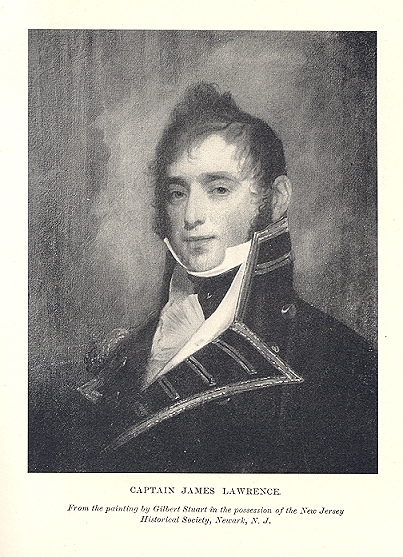
The newly appointed captain of the Chesapeake was James Lawrence whom we have briefly referred to in an earlier chapter.
Lawrence was born the youngest of eleven children in 1781 at Burlington, New Jersey. Though the family started their young boy in the study of law, he was eventually entered into the Navy as a midshipman at the age of 17. By the age of 21, he was serving as a Lieutenant aboard ships in the Mediterranean when the United States was at war fighting the Barbary pirates. In 1804, he was Stephen Decatur's second in command when an expedition was sent to destroy the captured American ship, Philadelphia. The Americans made their way into the harbour at Tripoli and destroyed the Philadelphia.
After his Mediterranean service, Lawrence was given the command of a succession of ships, including, the Vixen, Wasp and Argus. In 1810, he was promoted to the rank of Master Commandant and took command of the sloop of war Hornet and from the beginning of the War of 1812, Lawrence was very active in the Hornet.
It will be remembered that Lawrence met up with HMS Peacock during February of 1813. The two ships met in a single duel off the northeast coast of South America. In the exchange the Peacock lost. Out of a crew of 110 on the Peacock, five were killed, including her captain, twenty-nine were wounded. "The Hornet received some trifling damage in her spars; and, out of 163 men and boys, had one man killed and two slightly wounded."17 This meeting between Hornet and the Peacock was the last of five naval duels, three between frigates and two between sloops, all favorable in issue to the United States ..."18 Lawrence became an American hero.
In naval warfare, it certainly counted if one side had more guns, viz, a bigger ship, but where the difference was not too great, it more often depended on, simply, better gunnery. We have already referred to how British naval captains failed to exercise their gunnery crews, a failure that showed up in losses to the Americans. The blame was thought to rest with the Admiralty as they were not liberal in their allowances of
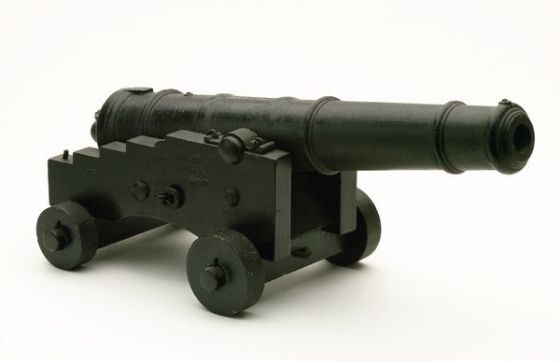
powder and shot. The captains had to, of necessity, restrict training in order to save for a real battle. By 1813, this niggardliness was corrected by the admiralty, or Broke found a way to load up on powder and shot sufficient to keep his gun crews practising most everyday.
Aboard the fighting sail ships were cannon lined up on the gun decks side by side with their muzzles ready to be stuck through a port hole built especially for them. A cannon is a gun of a size which requires it to be mounted for firing. Since it was then necessary to load the powder and shot from the muzzle they had to be wheeled in for loading and then wheeled out through the port to fire. They usually fired in unison at the signal of the gunnery officer who carefully gaged the roll of the ship. On the roll down, the order would be given if the object was to put holes in the adversary's hull; on the roll up, if the object was to cut the sails and the rigging. The ball could be blasted at a target up to a mile away.19 In naval battles, however, the preferred distance between ships before firing was at a "half pistol shot" or about 100 yards. One reads of "42 pounders," or "24 pounders," or "8 pounders": this was a convenient way of describing the size of the cannon, it describes the weight of the ball. The 42-pounder was the largest but "it was found only on the lower deck of the First Rates. The principal weapon of ships of the line was the 32-pounder - the largest gun which could be used efficiently in action."20 Cannon had to be lit quickly and conveniently. On the deck was a match tub. It was a tub with a perforated cover for holding slow matches and contained a little water on the bottom, for extinguishing unwanted sparks. A slow match was one that was made with a slightly twisted hemp rope soaked in a solution of water and saltpeter. It burned at the rate of four or five inches an hour. This to be compared to a quick match, where the threads of cotton were soaked in a solution of gunpowder and other ingredients. It burned at the rate of one yard in thirteen seconds.21
In March of 1813, Shannon sailed from Halifax in company with another 38-gun frigate, the Tenedos. They were in search of "some of the far famed frigates" of the American navy. They were going to cruise Boston Bay. By the 2nd of April they were in a position to reconnoiter the harbour of Boston itself. It was known that the President was lying there, ready for sea. Sometime during the month of April, under the noses of the British, and with the assistance of foggy weather, the President slipped by and went to sea. There remained, however, in Boston, two other American frigates: the Constitution and the Chesapeake. The Constitution was undergoing "extensive alterations." However, the Chesapeake, an 18-pounder, 38-gun frigate, continued to lie in the harbour, apparently ready for sea.
Captain Broke was spoiling for a fight and did not want those in charge of the Chesapeake to think it would be an encounter with odds two to one, so, as mentioned, he sent his consort, the 38-gun Tenedos away.22 So at the end of May the Shannon was cruising Boston Bay alone. During this time she captured all vessels that she fell in with. Two of them were sent to Halifax but in order to do so he had to part with eight of his men. He could not afford to reduce his crew23 to any greater extent, thus a number of captured American vessels -- after their crews, key provisions and small items of value were taken out -- were burned. A good many rowboats filled with American crews from these destroyed vessels pulled to the docks of Boston with the news that their vessels were sunk by that dam British ship hovering off the mouth of the harbour. Each time they relayed the oral invitation of Captain Broke that, as far as the Shannon was concerned, the Chesapeake had an appointment, if she cared to keep it. Broke was beginning to despair that he would ever have a go at the American frigate, and thinking maybe that the Americans were not getting his message, wrote the following address to the Captain of the Chesapeake:
"As the Chesapeake appears now ready for sea, I request you will do me the favour to meet the Shannon with her, ship to ship, to try the fortune of our respective flags. The Shannon mounts twenty-four guns upon her broadside and one light boat-gun; 18 pounders upon her main deck, and 32-pounder carronades upon her quarter-deck and forecastle; and is manned with a complement of 300 men and boys, beside thirty seamen, boys, and passengers, who were taken out of recaptured vessels lately. I entreat you, sir, not to imagine that I am urged by mere personal vanity to the wish of meeting the Chesapeake, or that I depend only upon your personal ambition for your acceding to this invitation. We have both noble motives. You will feel it as a compliment if I say that the result of our meeting may be the most grateful service I can render to my country; and I doubt not that you, equally confident of success, will feel convinced that it is only by repeated triumphs in even combats that your little navy can now hope to console your country for the loss of that trade it can no longer protect. Favour me with a speedy reply. We are short of provisions and water, and cannot stay long here."24
It was likely that this written message was not received before the Chesapeake let slip her lines and proceeded out of Boston harbour with the intention of putting an end to the effects of the Shannon's blockade of Boston. It was at about thirty minutes past noon, while the men were below at dinner, that Captain Broke was called on deck, and then he went himself to the masthead to see, to his joy, the Chesapeake, in a fair wind, making sail while proceeding out of Boston harbour. Behind her were a number of pleasure-boats carrying spectators eager to witness the whipping of a British frigate.25 It took a few hours for the ships to close.26 The Chesapeake steered a direct course for the Shannon coming up from behind on her right rear side, her starboard quarter. The Shannon came up into the wind somewhat which had the effect of slowing her down, so that her pursuer could catch up. The Shannon was at the ready.
"She was prepared for action, chain braces rove, top gallant and royals furled tight and small, but the yards across. She was under her three top sails and jib, her mizzen in throat brails, colours hoisted, the crew at quarters, magazine open, lockers full of shot, everything ready for action."27
The Chesapeake had old glory flying from every pole, or sail mast: fore, main and mizzen; a proud and bright ship she was.
"At the fore was a large white flag, bearing the motto, "SAILORS' RIGHTS AND FREE TRADE,: and at the mizzen, peak and in the starboard main rigging, the stars and stripes were displayed in all the pomp imaginable. The Shannon afforded to this display a singular contrast. Her sides, for a length of time untouched by a paint-brush, appeared to much disadvantage when compared with the bright sides of the Chesapeake; and instead of being bedecked with flaunting ensigns, a small union-jack at the fore, a rusty old blue ensign at the gaff-end, and another on the main-stay, formed the only additions to her usual sea equipage. The good order which reigned within, however, was a matter of much more consequence than outside show."28
The Chesapeake, likely because she had more sail up and because she was running more down on the wind, was moving through the water at a greater speed, or as sailors would say, "she had more way on." She was soon about to overlap the Shannon, who, in the meantime, was purposely slowing herself down by having less sail up and by keeping her bow more to the wind. Then the Chesapeake "luffed up," that is to say she too came more into the wind. She turned her bow to the right onto a course more parallel, and just behind and to the left of her adversary. The Chesapeake, however, still had more way on. At about the time the Chesapeake's bow was about to overlap the Shannon's stern, at a distance of about fifty yards, the Chesapeake's crew gave out three cheers, much the same as an enthusiastic playing team would give out just before the sound of the bell or horn that starts the game.
"As the Chesapeake drew near, Broke summoned his crew, and made a brief, hearty, rather grim speech. It was no time for one of those half jolly little harangues with which some of the old school used to herald an attack on a Frenchman. We had several beatings, and Broke knew the responsibility. 'Don't cheer,' he said; 'go quietly to your quarters.' And when a seaman, looking up at the rusty blue ensign on the mizzen peak, asked, 'Mayn't we have three ensigns, sir, like she has,' 'No,' said Broke, 'we've always been an unassuming ship.'"29
The Shannon's gun crews were ready to go through the motions automatically even if they may become blind and deaf in the smoke and roar of the battle.
"... the aftermost gun on the main deck contained two round shot and a keg of 150 musketballs; the next gun, one round and one double-headed shot, and so on alternately with every gun on the main deck. The captain of the fourteenth gun on the main deck, William Mindham, received orders to fire as soon as his gun would bear upon the Chesapeake's second port from forward; and this order he implicitly obeyed. At 5h. 50m. the gun was fired, and the shot was observed to take effect within a trifle of the spot pointed out. Every gun upon the broadside was fired with equal correctness of aim."30
In a moment, pounds and pounds of shot whistled across the water covering the short distance between the Shannon and the Chesapeake: pieces of flying iron some finding their mark, some not. And what were the marks: hull, gear, cordage, and men.
[NEXT: Pt. 5, Ch. 12 - "The Shannon and the Chesapeake," Part 2.]
